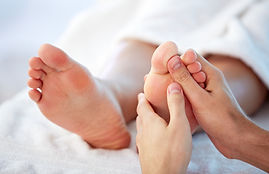BAO Massage


Reflexology
Reflexology is a therapeutic method of relieving pain by stimulating predefined pressure points on the feet. Reflexologists work from maps of predefined pressure points that are located on the hands and feet. These pressure points are to connect directly through the nervous system and affect the bodily organs and glands. The reflexologist manipulates the pressure points according to specific techniques of reflexology therapy. By means of this touching therapy, any part of the body that is the source of pain, illness, or potential debility can be strengthened through the application of pressure at the respective foot or hand location.
In the absence of any particular malady or abnormality, reflexology may be as effective for promoting good health and for preventing illness as it may be for relieving symptoms of stress, injury, and illness.
CranioSacral Therapy
What is CranioSacral Therapy?
CranioSacral Therapy (CST) is a gentle, hands-on approach that releases tensions deep in the body to relieve pain and dysfunction and improve whole-body health and performance. It was pioneered and developed by Osteopathic Physician John E. Upledger after years of clinical testing and research at Michigan State University where he served as professor of biomechanics.
Using a soft touch which is generally no greater than 5 grams – about the weight of a nickel – practitioners release restrictions in the soft tissues that surround the central nervous system. CST is increasingly used as a preventive health measure for its ability to bolster resistance to disease, and it’s effective for a wide range of medical problems associated with pain and dysfunction.
How does CranioSacral Therapy Work?
Few structures have as much influence over the body’s ability to function properly as the brain and spinal cord that make up the central nervous system. And, the central nervous system is heavily influenced by the craniosacral system – the membranes and fluid that surround, protect and nourish the brain and spinal cord.
Every day your body endures stresses and strains that it must work to compensate for. Unfortunately, these changes often cause body tissues to tighten and distort the craniosacral system. These distortions can then cause tension to form around the brain and spinal cord resulting in restrictions. This can create a barrier to the healthy performance of the central nervous system, and potentially every other system it interacts with.
Fortunately, such restrictions can be detected and corrected using simple methods of touch. With a light touch, the CST practitioner uses his or her hands to evaluate the craniosacral system by gently feeling various locations of the body to test for the ease of motion and rhythm of the cerebrospinal fluid pulsing around the brain and spinal cord. Soft-touch techniques are then used to release restrictions in any tissues influencing the craniosacral system.
By normalizing the environment around the brain and spinal cord and enhancing the body’s ability to self-correct, CranioSacral Therapy is able to alleviate a wide variety of dysfunctions, from chronic pain and sports injuries to stroke and neurological impairment.
What conditions does CranioSacral Therapy address?
Migraines and Headaches
Chronic Neck and Back Pain
Stress and Tension-Related Disorders
Motor-Coordination Impairments
Brain and Spinal Cord Injuries
Chronic Fatigue
Fibromyalgia
TMJ Syndrome
Scoliosis
Central Nervous System Disorders
ADD/ADHD
Post-Traumatic Stress Disorder
Orthopedic Problems
And Many Other Conditions
How many CranioSacral Therapy sessions will I need?
Response to CST varies from individual to individual and condition to condition. Your response is uniquely your own and can''t be compared to anyone else''s — even those cases that may appear to be similar to your own. The number of sessions needed varies widely — from just one up to three or more a week over the course of several weeks.